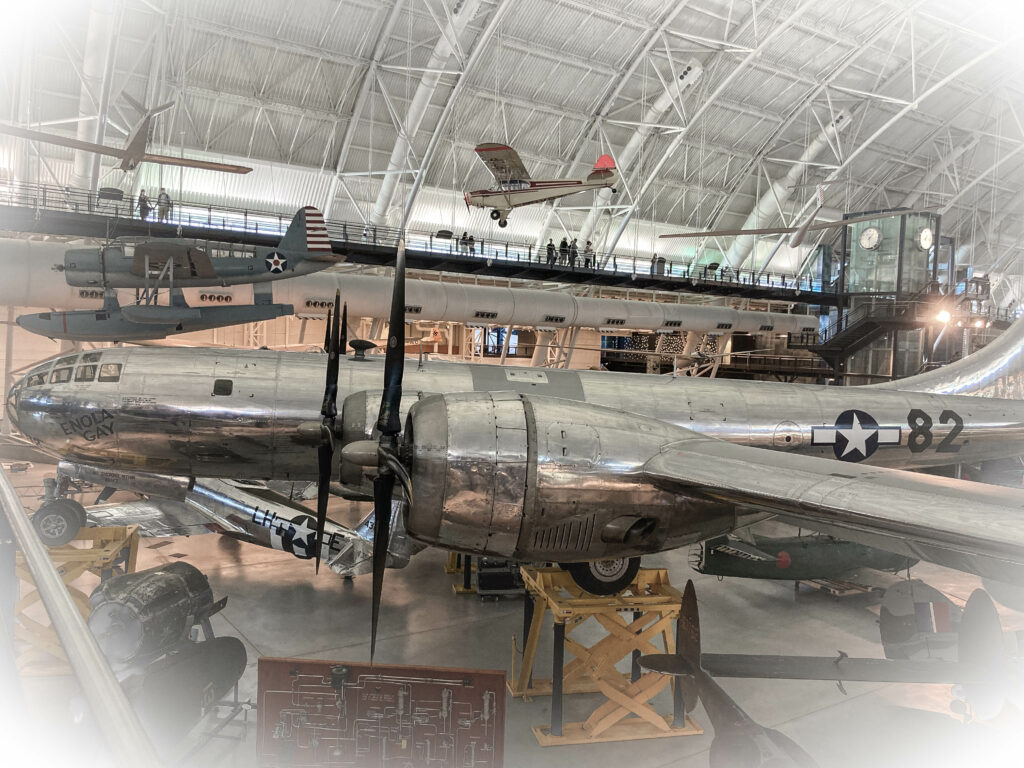Planes hang from above. Rockets stand tall.
Artifacts proclaim the story of air and space exploration, and what it has meant for war and peace, art and science, hope and heartache.
The Steven F. Udvar-Hazy Center in Chantilly, Virginia, is the partner facility to the Smithsonian‘s main National Air and Space Museum in Washington, D.C.
If you’re captivated by the wonders of air and space flight, this is the place for you.
Its two massive display hangars house dozens of historically significant air- and spacecraft, along with thousands of smaller artifacts.
Among the most significant are:
This post contains affiliate links. For more information, click here.
Enola Gay
On August 6, 1945, the B-29 Superfortress Enola Gay dropped the first atomic bomb on Hiroshima, Japan. On August 9, the United States bombed Nagasaki. President Harry S Truman believed that these attacks would convince Japan that defeat was inevitable and bring an end to World War II. On August 15, Emperor Hirohito announced that Japan would unconditionally surrender. On September 2, Japan formally did so aboard the U.S.S. Missouri.
SR-71 Blackbird
Almost as soon as World War II ended, the Cold War began: The United States and the Soviet Union, victorious allies, began competing for primacy in a global struggle pitting Constitutional republicanism against totalitarian communism. Tensions between the two superpowers heightened with episodes like the building of the Berlin Wall in 1961.
During the same decade, Lockheed developed its top-secret, stealthy SR-71 Blackbird, a long-range, high-altitude, Mach 3+ aircraft, used for aerial reconnaissance — surveillance and intelligence-gathering — in other words, a spy plane. Lockheed built 32; one of them is at Udvar-Hazy. With its sleek, cool, otherworldly vibe, it’s my favorite artifact at the museum.
U.S. superiority in technology like this was important for several reasons:
- It gave us strategic advantages.
- It showed the world that freedom was more productive than totalitarianism.
- It forced the Soviet Union to try to keep up, which it couldn’t do because its communist system could not produce sufficient economic growth.
In 1987, President Ronald Reagan stood in Berlin and demanded, “Mr. Gorbachev, tear down this Wall!” Two years later, in 1989, the Wall began to come down. Two years after that, in 1991, the Soviet Union collapsed. America had won the Cold War without firing a shot.
Discovery
The Space Race was also important during the Cold War. Discovery was America’s third Space Shuttle orbiter vehicle. She entered service in 1984 and flew 39 missions, spending 365 days in space and travelling almost 150 million miles. She shuttled 184 crew members out into space and back home to earth.
The Udvar-Hazy Center also offers thousands of lesser-known artifacts to view.
The museum houses an impressive collection of WWII-era planes, including the P-38 Lightning and P-51 Mustang. These aircraft hearken back to a time of daring pilots and ground-breaking technology — and they played key roles in the victory won by America and our allies.
And there are lots of immersive experiences:
If you’re up for a thrill, you can test your piloting skills in one of the interactive flight flight simulators. You’ll get a sense of what it’s like to control a plane and experience the feel of combat.
You can also watch the conservation work underway on a number of artifacts, including the B-26 Marauder “Flak Bait”, which flew more missions than any other American plane during World War II, from the overlook above the Restoration Hangar.
There’s an Observation Tower with 360-degree views where you can see planes take off and land at nearby Washington Dulles International Airport.
And there’s an IMAX Theater where you can watch interesting and inspiring films.
The Udvar-Hazy Center is much more than a couple of hangars housing some cool planes and rockets. It offers an awe-inspiring journey through the history and future of flight and a chance to marvel at the works of human ingenuity. Whether you’re a dedicated air and space enthusiast, a history buff, or someone fascinated with the breadth of human achievement, the Udvar-Hazy Center has something for you.
What to Know before You Go to the Udvar-Hazy Center
The Udvar-Hazy Center is located at 14390 Air and Space Museum Parkway in Chantilly, Virginia. As a Smithsonian museum, Udvar-Hazy does not charge admission, but there is a fee to park before 4:00.
There is a cramped gift shop and a popular Shake Shack, which serves delicious burgers.
Wear comfortable clothes and walking shoes; the floors are hard. Allow 3 to 6 hours.
The closest luxury hotel is the Ritz-Carlton, Tysons Corner.
After my misspent youth as a wage worker, I’m having so much more fun as a blogger, helping other discerning travellers plan fun and fascinating journeys. Read more …

